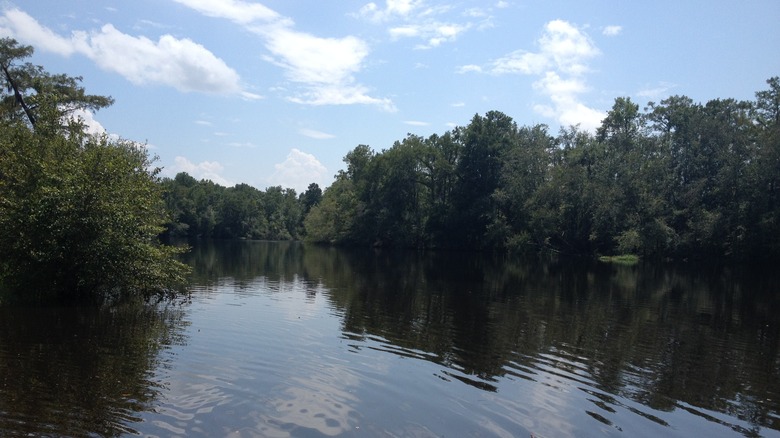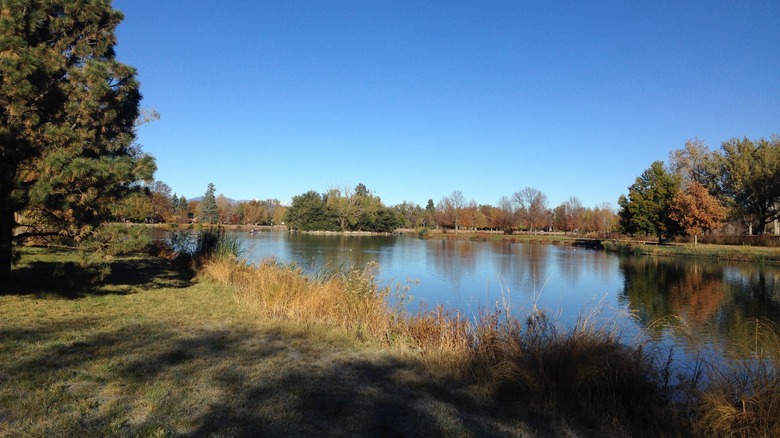South Carolina's Popular Scenic River For Water Fun Is Teeming With Alligators
The American alligator is something of the unofficial mascot of the warm, humid wetlands in the southeastern United States. For anyone who doesn't live in gator country, the state most associated with these intimidating reptiles is Florida. And, indeed, Florida has plenty of alligator-infested destinations where you can see the state reptile in person. However, the alligator's range extends beyond the borders of the Sunshine State. South Carolina, for example, has a sizable population of alligators of its own. Though it's known much more for Southern Charm than gator-infested wetlands, South Carolina has several rivers and lakes teeming with American alligators. In a somewhat worrisome twist, one of South Carolina's most alligator-infested waterways also happens to be one of its top recreational rivers. Though the Pee Dee River is quite popular among paddlers, anglers, and sightseers, it is equally popular with a certain reptilian predator lurking just below the surface.
The Pee Dee River is actually a somewhat multifaceted water system, even beyond its animal residents. Originating in North Carolina's stunning Blue Ridge Mountains (where it is known as the Yadkin River), the Pee Dee flows through South Carolina's rich Lowcountry and several urban areas before ending at Winyah Bay on the Atlantic. In South Carolina, the Pee Dee region lies less than two hours from both Columbia and Charlotte. And yet, the Pee Dee still retains much of its original character, fostering several distinct habitats and ecosystems throughout the state. These rich wetland habitats, combined with the state's generally warm climate, provide the perfect home for American alligators, and the Pee Dee and its tributaries offer arguably the best spots to see alligators in all of South Carolina.
The Pee Dee River is a paradise for travelers — and alligators
The Pee Dee River runs for about 203 miles across South Carolina, through a sizable river basin covering about 7,200 square miles in the Carolinas. The South Carolina portion bears the river's distinctive name from the Pee Dee Indian Tribe, whose traditional lands once stretched across the Pee Dee basin.
Today, much of the Yadkin-Pee Dee system is dammed, especially in North Carolina. However, the lower 90 miles of the Pee Dee in South Carolina are navigable. Though it's far from the longest river in the United States, the Pee Dee flows through a surprisingly diverse assortment of different ecosystems. In South Carolina, much of the river (particularly its navigable section) passes through warm and fertile coastal plains, surrounded by lush swamps, wetlands, and scenic cypress forests.
Wherever you have water-rich wetlands, you'll find animals adapted to live there. In the southeastern United States, that includes the American alligator. The Pee Dee and its surrounding waterways are among the most alligator-filled spots in all of South Carolina. Its brackish marshes and deep, murky swamps provide the ideal conditions for gators to lurk in search of prey, while the river's mud banks and sand bars are perfect for some much-needed gator sunbathing. The Pee Dee's rich habitats also mean plenty of food for hungry gators to enjoy, and a well-fed gator is usually a big gator. Many of the alligators caught in the Pee Dee have broken state records for size. In some cases, locals have caught alligators twelve feet in length! As if that wasn't concerning enough, the Pee Dee's location along many populated suburban areas often means its alligators end up in residents' backyards.
How to enjoy the Pee Dee in spite of the alligators
Despite its fearsome reptilian residents, the Pee Dee River remains one of South Carolina's top waterways for recreation. Because much of its South Carolina portion is undammed, the river features some of the state's best paddling trails. Many of the Pee Dee's tributaries, including the aptly-named Little Pee Dee River, are similarly great water routes for kayaking through peaceful, scenic waterways. A kayaking trip down the Pee Dee offers up-close views of picturesque, undeveloped marshes, woodlands, and gorgeous groves of cypress and tupelo trees.
Though there are a few rapids here and there, the Pee Dee is a relatively calm river overall. During periods of low water levels, exposed sandbars along the river make excellent camping spots for overnight paddling trips. Some parts of the Pee Dee even hold notable distinctions beyond being top paddling destinations. For example, the Pee Dee's confluence with the nearby Lynches River has been designated as part of the South Carolina Revolutionary Rivers Trail due to its association with Revolutionary War hero Francis Marion. Fishing is also popular along the Pee Dee, with many sections of the river rich in gar, bowfin, and carp.
If you're hesitant to partake in water recreation on a river with so many alligators, the Pee Dee also flows through South Carolina's eponymous Pee Dee region. With a rich culinary heritage and plenty of agriculture, Pee Dee is South Carolina's capital of barbecue, pecan pie, and U-Pick farms. The riverside Pee Dee town of Cheraw provides excellent river views (and access) and a unique jazz heritage. Of course, for amateur herpetologists, the region's top draw remains its boundless opportunities to see American alligators in the wild.


